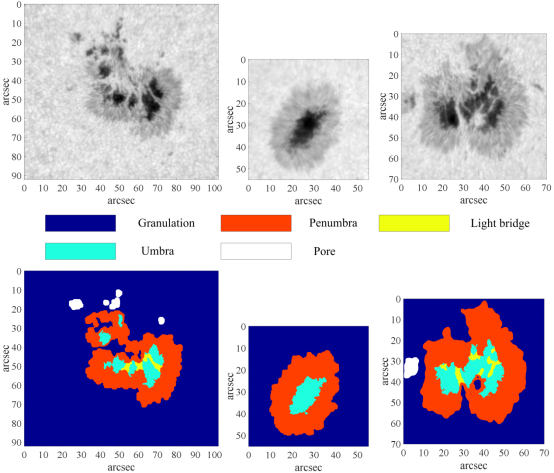Automated Segmentation of Sunspots Fine Structures
Through the algorithm by combining level-set method with morphological method and gray-level threshold, the degree of refinement of structure segmentation and the accuracy of feature recognition was greatly improved by a group from IOE, CAS in compared with previous research work.
Sunspots are the most obvious phenomenon on the solar photosphere and important manifestations of solar activity. They are also important signs of the influence of magnetic fields on the dynamics and structure of the sun. After many years of theoretical research and experimental observations, there are still many problems to be solved further about the formation mechanism and evolution process of sunspots. Today, the focus of solar-physics studies has already turned to small-scale structures, for example umbral cores, penumbra, light bridges, and pores. Statistical studies depended on large samples of fine structures help to further reveal the process of formation and extinction of sunspots and the dynamic characteristics of bright bridges. Therefore, in order to extract the feather of the sunspots fine structure, it is necessary to identify and segment these fine structures automatically.
Recently, under the support of the National Natural Science Foundation of China, the Solar High-Resolution Optical Imaging Research Group, led by Rao Changhui, from Key Laboratory on Adaptive Optics, Chinese Academy of Sciences of Institute of Optics and electronics, CAS, proposed a new method for automated segmentation the fine structure of the solar photosphere. This group fully made use of the advantages of ground-based large-aperture solar telescope with adaptive optics to obtain high-resolution images of the solar active regions, and then an algorithm by combining level-set method with morphological method and gray-level threshold was used to automatically segment the structural features into solar granulation , umbral cores, penumbra, light bridges, and pores. Through the algorithm, the degree of refinement of structure segmentation and the accuracy of feature recognition was greatly improved in compared with previous research work.
The research results were published in Solar Physics, a well-known international astronomy journal. For more, see https://link.springer.com/article/10.1007%2Fs11207-017-1236-7.

Solar active regions numbered NA12381, NA12483 and NA12599.The automatic identification and segmentation results of high-resolution image and fine structure feature at the TiO band,based on the 151-element solar adaptive optics system developed by IOE installed at the 1-m New Vacuum Solar Telescope of the Yunnan Observatory.
Contact
CAO Qiang
Institute of Optics and Electronics
Email: caoqiang@ioe.ac.cn
